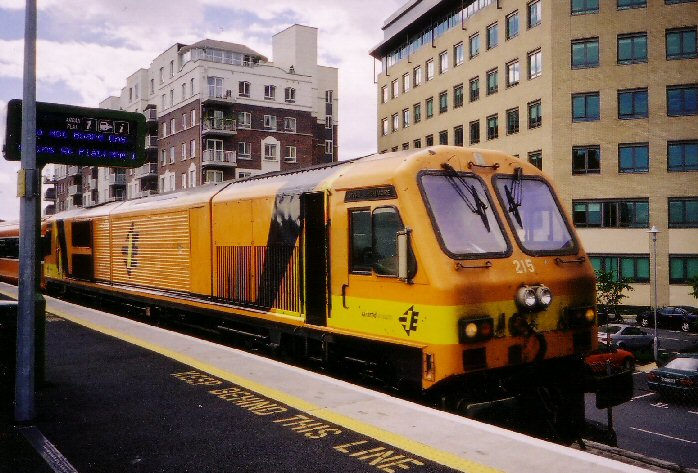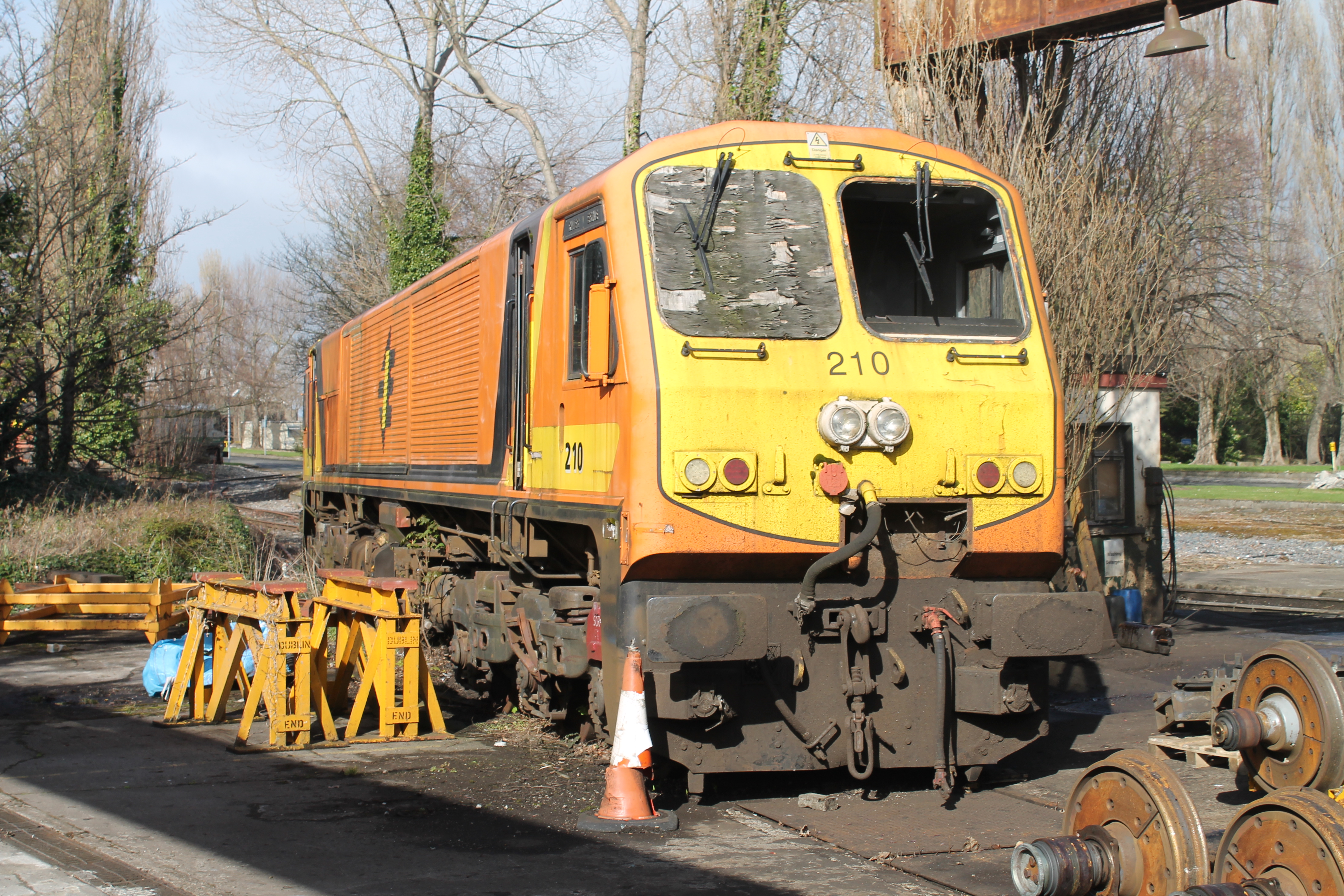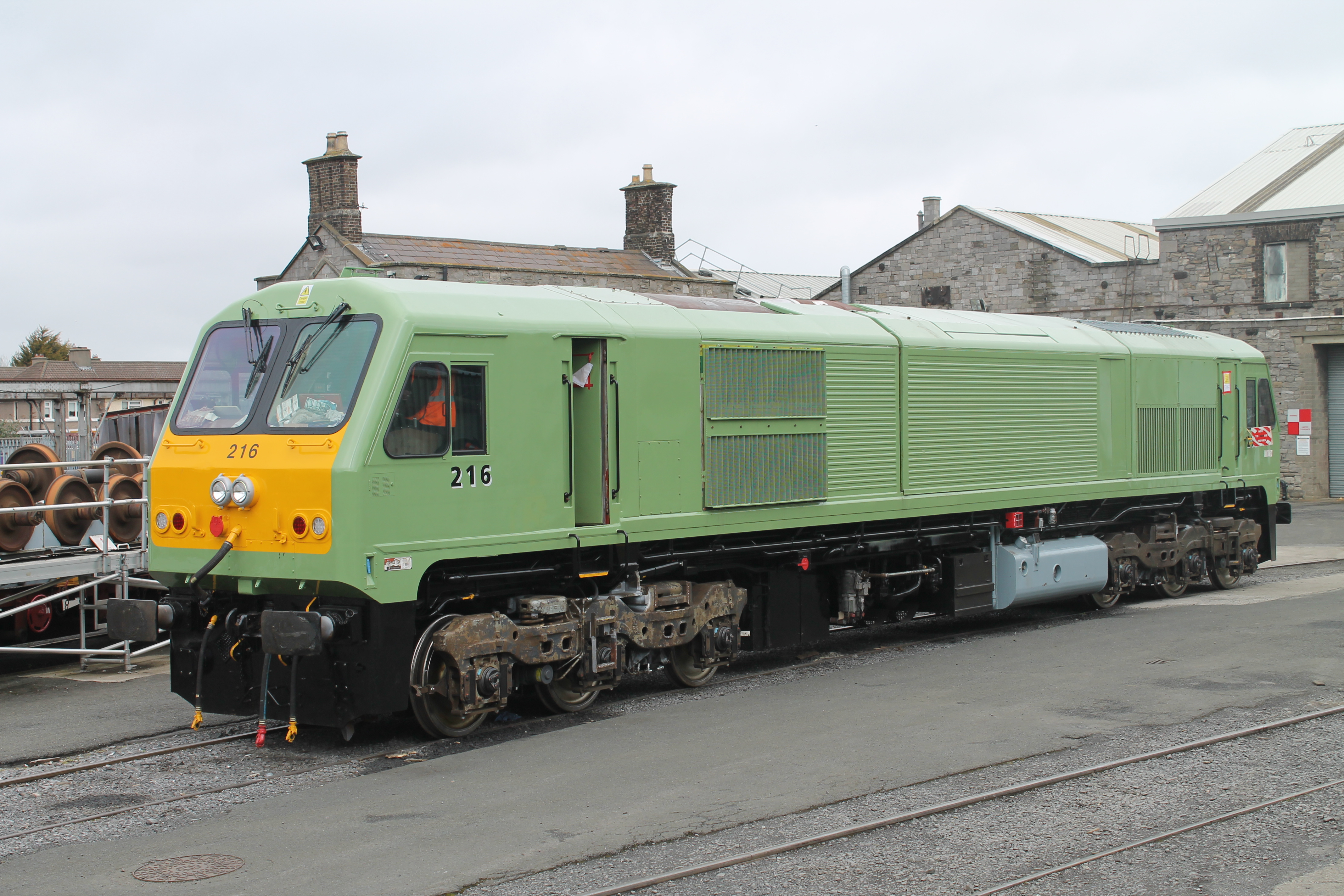IE 201 Class on:
[Wikipedia]
[Google]
[Amazon]
The








In 2011 Murphy Models launched a completely new version of the 201, with all wheel drive, centre can motor and preinstalled speaker. This was released in IÉ orange (original and revised), Green Intercity and NIR blue as well as NIR Enterprise original and revised. Railtec Transfers and Studio Scale Model
make transfers for the full range of 201 liveries, No's 201-234, original and updated Orange, original and updated Enterprise and Green Intercity. The 201 Class has also been released in virtual form as a player driveable locomotive in the
Iarnród Éireann Fleet Information website
{{DEFAULTSORT:Ie 201 Class 201 Class Electro-Motive Division locomotives Co-Co locomotives Railway locomotives introduced in 1994 Diesel-electric locomotives of Ireland Diesel-electric locomotives of Northern Ireland
Iarnród Éireann
Iarnród Éireann () or Irish Rail, is the operator of the national railway network of Ireland. Established on 2 February 1987, it is a subsidiary of Córas Iompair Éireann (CIÉ). It operates all internal InterCity, Commuter, DART and f ...
(IÉ) / Northern Ireland Railways 201 Class locomotives are the newest and most powerful diesel locomotives operating in Ireland and were built between 1994 and 1995 by General Motors Diesel
General Motors Diesel was a railway diesel locomotive manufacturer located in London, Ontario, Canada. It was established in 1949 as the Canadian subsidiary of the Electro-Motive Diesel division of General Motors (EMD). In 1969 it was re-organiz ...
. They are model type JT42HCW, fitted with an EMD 12-710G3B engine of , weigh and have a maximum speed of . A freight version, the EMD Series 66, with the same engine, is used on privately operated European mainline freight duties.
History
By the early 1990s the locomotives operating passenger services in Ireland were becoming increasingly obsolete, with the newest type in service being the 071 Class introduced in 1976. Theeconomic boom
An economic expansion is an increase in the level of economic activity, and of the goods and services available. It is a period of economic growth as measured by a rise in real GDP. The explanation of fluctuations in aggregate economic activi ...
in Ireland in the mid-1990s allowed Iarnród Éireann to begin significant investment in the infrastructure of the railways, which began with an order for 32 brand new express locomotives from GM-EMD
Progress Rail Locomotives, doing business as Electro-Motive Diesel (EMD), is an American manufacturer of diesel-electric locomotives, locomotive products and diesel engines for the rail industry. The company is owned by Caterpillar through its sub ...
. Northern Ireland Railways also purchased 2. The first were delivered in 1994, with deliveries continuing until 1995.
To allow clearance tests and driver training to commence in advance of the delivery of the main order of 201s, it was decided to transport the first locomotive, number 201, to Dublin by air. An Antonov An-124 was used to transport the locomotive from London, Ontario
London (pronounced ) is a city in southwestern Ontario, Canada, along the Quebec City–Windsor Corridor. The city had a population of 422,324 according to the 2021 Canadian census. London is at the confluence of the Thames River, approximat ...
to Dublin Airport
Dublin Airport ( Irish: ''Aerfort Bhaile Átha Cliath'') is an international airport serving Dublin, Ireland. It is operated by DAA (formerly Dublin Airport Authority). The airport is located in Collinstown, north of Dublin, and south o ...
, arriving on Thursday 9 June 1994. The first light-engine test run operated from Inchicore works to Kildare on the Tuesday 14.
Unfortunately, the locomotives have had a chequered service history. The authors of ''Jane's Train Recognition Guide'' noted that IÉ had had problems with engine fires and bogie cracks.
Technical details
*Main Generator Assembly: AR8PHEH/CA6 *Head End Alternator (HEP): Dayton-Phoenix, model E7145, 438 kVA, 220/380VAC, 3-phase, 50 Hz *Standby HEP: 220 kVA from AR8, available only when stationary *Auxiliary Generator: 5A-8147, *Air Compressor/Exhauster: Gardner Denver, model WLPA9B *Multiple Working: All IÉ & NIR EMD locos *Push Pull Working: Locos 206-209 & 215-234 * Curve Negotiation Capability: **Yard: **Running line: **Coupled to train:Equipment new to IÉ locos
*Air Dryer *Teloc 2200 Event Recorder *Electrically heated windscreens *Active noise control
Active noise control (ANC), also known as noise cancellation (NC), or active noise reduction (ANR), is a method for reducing unwanted sound by the addition of a second sound specifically designed to cancel the first. The concept was first develop ...
in both cabs
*Enclosed body style, last seen on 1950s Metro-Vic A and C Classes
*Head End Power
In rail transport, head-end power (HEP), also known as electric train supply (ETS), is the electrical power distribution system on a passenger train. The power source, usually a locomotive (or a generator car) at the front or 'head' of a train, p ...
(HEP)
**This system supplied AC power to the train for heating, battery charging, etc. and was intended to replace the Mark 2 & Mark 3 Generator Vans used at the time. In the event HEP was only used on the Enterprise cross-border De Dietrich service. HEP is no longer used due to noise while the train is in station, and reliability issues running the prime mover at high speed constantly. Four Mark 3 generator vans remain in use on the Enterprise service. The later CAF-built Mark 4 sets include their own generators in the Driving Van Trailer (DVT).
*EM2000 digital traction computer
*Train (carriage) door control
*D43 Traction Motors
*Super Series wheel creep control
*Cab mounted electronic fuel gauges
*Fire suppression system, FM200 extinguisher
Variants
There are three versions within the Class 201: *201 to 205 & 210 to 214 **Fixed buffers, shackle coupling *215 to 226, 229, 232 and 234 **Retractable buffers, automatic or shackle coupling, ** Push-pull capability, electronic fuel gauges *206 to 209, 227, 228, 230, 231 & 233 **Retractable buffers, automatic or shackle coupling, ** Push-pull capability, electronic fuel gauges **NIR train radio and TPWS/AWS
Amazon Web Services, Inc. (AWS) is a subsidiary of Amazon that provides on-demand cloud computing platforms and APIs to individuals, companies, and governments, on a metered pay-as-you-go basis. These cloud computing web services provide d ...
for cross-border service.
**HaslerRail 2500 Event recorder
Fleet


InterCity
Today push-pull equipped members of the 201 class operate the only passenger locomotive hauled services in theRepublic of Ireland
Ireland ( ga, Éire ), also known as the Republic of Ireland (), is a country in north-western Europe consisting of 26 of the 32 counties of the island of Ireland. The capital and largest city is Dublin, on the eastern side of the island. ...
between Dublin and Cork. They operate with Mark 4 carriages which were introduced to the route in 2006/2007. The current livery was introduced in 2006 and it primarily consists of green and silver. All locomotives have full yellow ends to enhance visibility.
Non push-pull locomotives were withdrawn from service because Mark 4 carriages operate a push-pull system and rolling stock on other InterCity routes was replaced by 22000 Class DMUs. The only other locomotive-hauled service (also push-pull) is the Enterprise cross-border service to Belfast
Belfast ( , ; from ga, Béal Feirste , meaning 'mouth of the sand-bank ford') is the capital and largest city of Northern Ireland, standing on the banks of the River Lagan on the east coast. It is the 12th-largest city in the United Kingdom ...
which is detailed below.
Enterprise
TheEnterprise
Enterprise (or the archaic spelling Enterprize) may refer to:
Business and economics
Brands and enterprises
* Enterprise GP Holdings, an energy holding company
* Enterprise plc, a UK civil engineering and maintenance company
* Enterprise ...
is a cross-border passenger service between Dublin
Dublin (; , or ) is the capital and largest city of Ireland. On a bay at the mouth of the River Liffey, it is in the province of Leinster, bordered on the south by the Dublin Mountains, a part of the Wicklow Mountains range. At the 2016 ...
and Belfast
Belfast ( , ; from ga, Béal Feirste , meaning 'mouth of the sand-bank ford') is the capital and largest city of Northern Ireland, standing on the banks of the River Lagan on the east coast. It is the 12th-largest city in the United Kingdom ...
operated by Iarnród Éireann
Iarnród Éireann () or Irish Rail, is the operator of the national railway network of Ireland. Established on 2 February 1987, it is a subsidiary of Córas Iompair Éireann (CIÉ). It operates all internal InterCity, Commuter, DART and f ...
and Northern Ireland Railways. This is also a locomotive-hauled service and operates a similar push-pull system like services to Cork
Cork or CORK may refer to:
Materials
* Cork (material), an impermeable buoyant plant product
** Cork (plug), a cylindrical or conical object used to seal a container
***Wine cork
Places Ireland
* Cork (city)
** Metropolitan Cork, also known as G ...
. As this is a jointly operated service, it is marketed as the "Enterprise" and the coaching stock and locomotives carry a separate livery to either operator's own services. It consists of light grey with a purple and red strip. Locomotives also have full yellow ends to enhance visibility.
As the service is shared, locomotives (8)208 and (8)209 are owned by Northern Ireland Railways. The coaching stock is owned by operators, Iarnród Éireann own the odd numbered coaches and NIR own the even numbered coaches.
In addition, Iarnród Éireann introduced four former Mark 3 generator vans, in September 2012, to operate this route, in a bid to improve reliability of the service and reduce maintenance costs. Previously, the service operated with head end power
In rail transport, head-end power (HEP), also known as electric train supply (ETS), is the electrical power distribution system on a passenger train. The power source, usually a locomotive (or a generator car) at the front or 'head' of a train, p ...
and this caused regular locomotive failures, increased wear and tear and also contributed to locomotive 230 being removed from service in June 2013 after an engine fire, while operating a passenger service with HEP in operation.
Freight
201 Class locomotives also operate some freight services as required. There is a container flow between Dublin Port and Ballina. Since 2016 some 201 Class locomotives have operated increased freight services, as the weight and length of some freight services was increased, due to customer demand.Common livery
Locomotives 231 and 233 are painted in a common livery, which consists of light grey with a black stripe. The reason for this is that they are assigned for Enterprise duties and as part of the refurbishment of the Enterprise service, in 2015-2016, only six were given the full livery. Prior to this, some of those given the current livery had previously had the InterCity livery. As part of Iarnród Éireann's logo change, all InterCity 201's carry the new Iarnród Éireann logo, which includes the Irish flag, and for operational and safety reasons they do not operate cross border services, so a common colour scheme was adopted.List of locomotive names
The entire class is named after Irish rivers, with the IÉ locomotives carrying two nameplates, one in Irish and one inEnglish
English usually refers to:
* English language
* English people
English may also refer to:
Peoples, culture, and language
* ''English'', an adjective for something of, from, or related to England
** English national ...
, on each side of the locomotive. As 208 and 209 are owned by Northern Ireland Railways, they carry English language only nameplates. The nameplates are trapezium shaped, with the names in upper case.

Current operations
All of the non push-pull capable locomotives (201–205 and 210–214) were placed in storage at Inchicore during 2009, the last being 214 in July 2009. This was due to the withdrawal of the Mark 3 fleet and their replacement with 22000 Class DMUs on the vast majority of passenger services. This left only the Mark 4 Dublin–Cork services and the cross-border Enterprise service (with De Dietrich rolling stock) as the only locomotive hauled passenger services operated by Iarnród Éireann. The reduction in the number of locomotive hauled passenger workings, combined with the withdrawal of older GM locomotives, has seen 201 Class locomotives used on freight workings, whilst four push-pull capable units were transferred to join the original four dedicated locomotives in use on the Enterprise. In 2010 Iarnród Éireann planned to store some of its remaining push-pull capable Mark 3 coaches, which could potentially have been used with 201 Class locomotives to enhance Enterprise's service. However, most Mark 3 carriages were scrapped during 2013 and 2014. A fleet of 10 Mark 3 coaches were sold toBelmond Grand Hibernian
The ''Belmond Grand Hibernian'' was a luxury train service in Ireland. The service was operated by Belmond, the operator of several other luxury trains including the '' Venice Simplon Orient Express''. It was officially launched on 30 August 2 ...
, while 216 and 225 were earmarked be returned to service to handle the extra traffic generated by Belmond operation. In May 2016, 216 returned to service in Belmond livery, and has operated the Grand Hibernian almost exclusively since that time.
225 was stopped after a fatal level crossing collision in 2010 which caused extensive underframe damage. On the 24th of October 2019 225 returned to traffic on IWT duties. After extensive testing, was returned to passenger service on 8 November 2019.
In October 2011 233 suffered bearing failure en route to Connolly station from Belfast. It was transported by road to Inchicore Railway Works
On 15 February 2016 two 201 Class locomotives (226 & 209) operated freight trials with a long train of 15 HOBS ballast wagons plus one un-powered loco, possibly assessing the loco's capabilities for future freight services.
In October 2016 Iarnród Éireann expressed an interest in seeking solutions to re-power most of the fleet during a mid-life refurbishment. The requirement was for floor-up engine and control gear solutions, which kept the existing cab controls and compatibility with the existing GM fleet and push/pull equipment. The body, cab controls, bogies, and traction motors would remain unchanged. 201 and 205 were brought in from storage for internal and external inspection, possibly in relation to this re-powering. The re-powering project was originally scheduled to begin in the first quarter of 2017, but was cancelled in early 2019.
In July 2017, 230 received some bodywork repairs after it suffered significant damage, due to a fire in the HEP system in 2013. The loco has been in storage since.
In July 2020, 224 suffered a serious failure to its underframe. The official RAIU report, issued in July 2021, concluded that a weld repair to a non-structural bed plate had been unnecessarily applied to a structural chassis plate, causing an eventual structural failure of the locomotive.
It is worth noting that they cannot operate on the Larne line due to weight clearance.
Model
In the late 1990s, Model Irish Railways produced a resin bodyshell kit withnameplate
A nameplate identifies and displays a person or product's name. Nameplates are usually shaped as rectangles but are also seen in other shapes, sometimes taking on the shape of someone's written name. Nameplates primarily serve an informat ...
s, numbering, brass grills and the standard yellow / black livery line transfers. Marks Models also released a resin kit for these locomotives in 00 gauge in c.2000.
In 2001, Murphy Models commissioned LIMA to produce an '00' gauge 201 model loco. They were produced in IÉ orange (201, 216, 217, 219, 230) and Enterprise (206, 207, 208, 209) liveries, in batches of 300 (except 500 of #207).In 2011 Murphy Models launched a completely new version of the 201, with all wheel drive, centre can motor and preinstalled speaker. This was released in IÉ orange (original and revised), Green Intercity and NIR blue as well as NIR Enterprise original and revised. Railtec Transfers and Studio Scale Model
make transfers for the full range of 201 liveries, No's 201-234, original and updated Orange, original and updated Enterprise and Green Intercity. The 201 Class has also been released in virtual form as a player driveable locomotive in the
Microsoft Train Simulator
''Microsoft Train Simulator'' is a 2001 train simulator developed for Microsoft Windows. It was released on May 31, 2001, and developed by the UK-based company Kuju Entertainment. It sold one million units worldwide by 2005.
Features
Microsof ...
add-on, "Irish Enterprise North", by Making Tracks, and for OpenBVE by Celtic Trainsim.
References
External links
Iarnród Éireann Fleet Information website
{{DEFAULTSORT:Ie 201 Class 201 Class Electro-Motive Division locomotives Co-Co locomotives Railway locomotives introduced in 1994 Diesel-electric locomotives of Ireland Diesel-electric locomotives of Northern Ireland